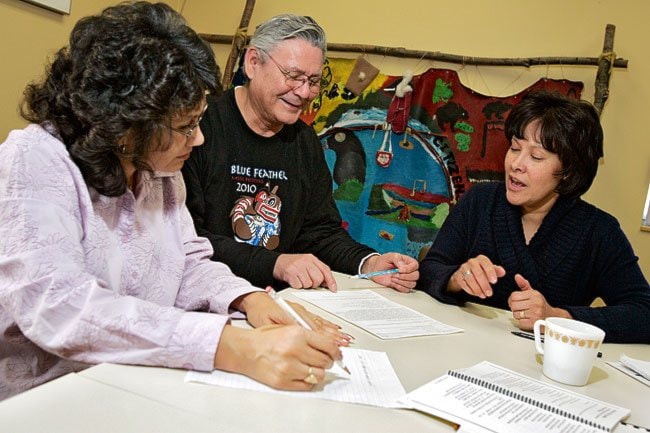Sharon Shadow’s childhood was full of sounds she can’t hear anymore.
She grew up in Haines Junction with her grandmother, whose own mother tongue was Southern Tutchone.
The acoustic landscape of the language - the glottalized stops, the voiceless “I"s and the four tones her grandmother once pronounced -
were etched into Shadow’s memory through traditional stories.
“I heard those stories when I was younger and now I don’t hear those stories anymore,” said Shadow, who works in the Department of Education promoting First Nation languages in the school system.
“Now, we’re at a crisis with our languages,” she said.
Shadow was a non-status aboriginal, which means she wasn’t sent to residential school, a place where First Nation languages were banned.
“That caused a disruption in the transmission of the language,” she said.
But even if she spent more time in a Southern Tutchone home than her contemporaries, she wasn’t able to achieve fluency.
“For my generation, we didn’t use the language really,” she said.
Other than stories, Southern Tutchone was sung during ceremonial potlatches.
Shadow, who is in her 50s, never stopped chasing down the dream of reviving the language of her grandmother.
A few years ago, she and a number of other First Nation people in the education field began studying in the First Nations Language Proficiency Program, a joint project between the Yukon Department of Education and Simon Fraser University.
After two years of mentoring under two Whitehorse Southern Tutchone-speakers, Lorraine Allen and Hazel Bunbury, Shadow can now manipulate the language enough to begin improving the language curriculum for young aboriginals.
“Though I don’t speak it, I can understand the language,” she said.
Yukon First Nations have been studying, compiling and archiving their languages in a modern form since at least the 1970s.
The first to document Southern Tutchone, Daniel Tlen, returned to his hometown of Burwash Landing after studying linguistics at the University of Victoria.
Tlen, who is also a Department of Education employee, recorded Southern Tutchone-speakers in Burwash, and then went on to create language lessons, a noun dictionary, and a collection of stories and songs, says the Yukon Native Language Centre’s website.
The centre continues that work by compiling and sharing language aids for all eight Yukon First Nations.
But it’s unlikely the languages will ever be spoken in everyday use again, said Shadow.
“To become fluent, I don’t know if we can ever attain that again,” she said.
“I guess it’s more about who we are,” she said.
“Language is such a big part of our identity.”
Passing on that linguistic inheritance isn’t easy.
During sets of six-week courses over two years, Shadow had to learn 200 new Southern Tutchone words.
She and the other students would write down ideas on what they wanted to learn from their mentors.
“If I wanted to learn about potlatches or living on the land, I’d jot down some ideas,” she said.
Then the mentor would offer a lesson on all the words related to the theme.
“We would write that down and then we would record the mentor with our iPods,” she said.
The students would listen to the iPod recordings over the course of the week until the next session, where the mentors would correct pronunciation.
“Listening to the language and speaking is the key,”
she said.
Shadow and the other people in the program are now working those languages into school curricula.
There’s already lessons offered between kindergarten and Grade 7 in the Yukon, and then another course in Grade 10.
In Whitehorse, students can learn Southern Tutchone and Gwitchin.
Shadow believes preserving ancient languages isn’t just about keeping a culture alive.
It opens a door into the question of whether different languages shape the way people think.
“It has to,” she said.
Southern Tutchone is very versatile when it comes to describing life on the land, she said.
“We have a lot of directional phrases,” she said.
“In Southern Tutchone, if we say ‘over there,’ it could be ‘it’s over there a little ways,’‘it’s over there a little further’ or ‘it’s quite a ways over there,’” she said.
“And whether it’s up hill or down hill or if it’s across water.”
Linguistic relativism, which is undergoing a revival of late, includes looking at the way directional terms might shape spatial thinking.
Studies of Guugu Yimithirr, an ancient Australian language, revealed a vast use of cardinal directions, but no for words for left or right, according to an August article in the New York Times Magazine.
Some linguists see this as the source for the many ways Aborigines treat space and direction differently than Europeans.
Other recent studies show how our perception of colours can be determined by language.
Many languages see green and blue as shades of the same colour, and that linguistic factor can determine how we train our minds to distinguish among colours, according to the magazine.
It could be a long time before the psychological impacts of speaking Southern Tutchone on the speaker are known, if ever.
“It’s something that’s a lifetime journey for anyone,” said Shadow.
She’s is currently focusing on a project with the Champagne-Aishihik First Nation for children in kindergarten and Grade 1.
Colleen Joe-Titus was the other only person to receive a degree from her studies in First Nations languages.
Bess Cooley, Nancy Sterriah, Georgina Stone, Connie Jules, Kathy Magun and Melissa Hawkins all received certificates in First Nations language proficiency from the program.
Contact James Munson at
jamesm@yukon-news.com
